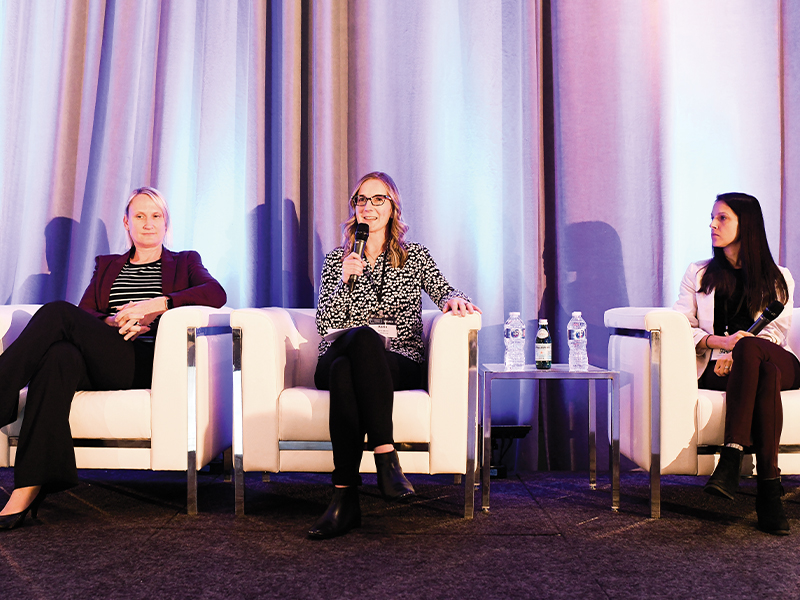
As the coronavirus pandemic prompted a meaningful change in how employers communicate with their workforces, Telus Communications Inc. reviewed job types and created personas around these employee groups, communicating well-being information differently depending on the persona.
“We were doing that before, but it became even more important during the pandemic and . . . in the space we’re in now, we’re continuing to focus on that because it becomes a lot more meaningful and impactful,” said Janet Young (left), the company’s director of well-being and health services, people and culture, during a panel session at Benefits Canada‘s 2022 Healthy Outcomes Conference.
Prior to the pandemic, TMX Group Ltd. made remote technology available and pilot tested it, but the organization’s culture was strongly office-based, so the pivot was significant, said Karin Adams (centre), its vice-president of talent and total rewards, also speaking on the panel. The company launched a virtual watercooler, where employees could chat about non-work topics like recipes and television shows, and it ran contests, such as asking employees to share how they were beating the winter blues to win a prize.
Read: 70% of employees satisfied with employer communications around coronavirus: survey
“It’s certainly not the same, but we tried to replicate and provide a conduit to making connections and keep people feeling like they were connected to the workforce.”
The majority of LifeLabs’ employees are deemed frontline, essential workers, but some shifted to working remotely, said Crystal Arnold (right), the company’s senior manager of wellness, retirement and group benefits. To keep remote employees feeling connected, the organization increased the number of virtual team meetings, coffee chats and virtual wellness Wednesdays.
For all three employers, support for managers has been a key part of the communications strategy. TMX started biweekly meetings with people managers, run by its chief executive officer, to answer questions, communicate messaging and provide peer support. “The first thing we realized is the experience of the pandemic for people was largely going to be shaped by their people manager. They’re maybe not having the same peer network, so that relationship between them and their people manager was significant.”
LifeLabs has long relied on its people managers to share information with frontline employees who are spread across Canada and don’t have a work laptop or time in the day to check their emails. It provided managers with fulsome FAQs and a greater presence from Arnold’s team at departmental meetings to share information.
Read: Injecting communications with kindness and confidence during the coronavirus crisis
Telus’ well-being team immediately began conversations with leaders about the importance of supporting their teams, said Young, noting her team is reinforcing the changing expectations of people leaders and the importance of modelling self-care to give employees permission to take care of themselves as well.
All three employers also said they’re evolving their communications strategies to reflect changing employee needs. LifeLabs heard from frontline workers that they didn’t know what benefits and supports were available, so it shifted the way material was presented. This includes sharing quick, engaging videos and a regular interview segment with the president and CEO, said Arnold.
While TMX’s initial communications and regular webinars were a hit with employees, Adams said the company has scaled those back to respect employees’ time. And while it’s also reduced the amount of employee surveys, she noted TMX’s listening strategies are here to stay. “Employees got a voice in the pandemic and it’s becoming even stronger as we come out of it. There’s an expectation that we’re listening and that we’re acting.”
Read more coverage of the 2022 Healthy Outcomes Conference.
